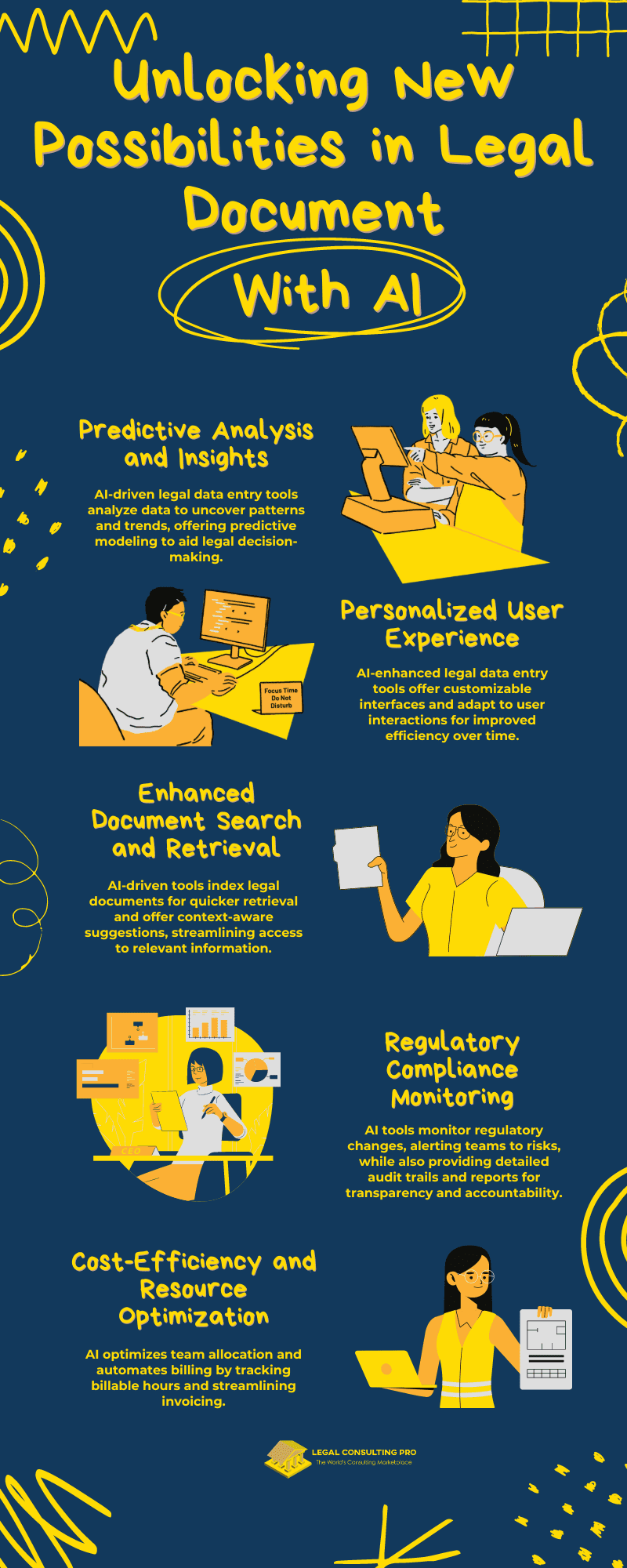In the realm of litigation support services practice, data entry has long been perceived as a mundane task—yet, it forms the cornerstone of accurate legal document creation and management. With the advancement of technology, particularly Artificial Intelligence (AI), the landscape of legal data entry is transforming. The integration of AI-powered tools is not only enhancing the efficiency and accuracy of data entry but also revolutionizing the way litigation support services professionals approach document management and litigation support services.
Understanding AI-Powered Legal Data Entry
As AI technologies continue to evolve, their application in the litigation support services field has expanded beyond mere automation to encompass sophisticated data processing and analysis capabilities. AI-powered legal data entry is at the forefront of this transformation, leveraging advanced algorithms and machine learning techniques to streamline workflows, enhance accuracy, and unlock new possibilities in document management.
Intelligent Data Extraction
Automated Data Capture and Contextual Understanding
AI-powered tools offer a dual advantage in the litigation support services industry by automating data capture from legal documents and providing contextual understanding.
These tools can automatically extract relevant information from a variety of litigation support services documents like contracts, agreements, and court filings. This automation not only reduces manual effort but also minimizes the risk of human error, ensuring that data extraction is efficient and accurate.
Moreover, advanced AI algorithms enable these tools to understand and interpret the context in which data appears. They can distinguish between different types of information such as names, dates, amounts, and other critical details. This contextual awareness plays a crucial role in ensuring accurate data classification and organization, making it easier for legal professionals to access and utilize the extracted information effectively.
In summary, AI-powered tools with automated data capture and contextual understanding capabilities are transforming the litigation support services industry by streamlining document management, reducing errors, and enhancing data organization.
Natural Language Processing (NLP)
Interpreting Legal Text and Legal Clause Identification
AI technologies, particularly Natural Language Processing (NLP), are revolutionizing the way litigation support services professionals interact with documents.
NLP capabilities empower AI systems to understand and interpret the intricate language and specialized terminology commonly found in legal documents. This proficiency ensures more accurate data extraction and entry, making the process of reviewing and analyzing legal documents more efficient and reliable.
Additionally, AI-powered tools can automatically identify and extract specific legal clauses or provisions from documents. This feature facilitates faster and more targeted review by litigation support services professionals, allowing them to quickly locate relevant clauses without manually searching through lengthy documents.
By combining NLP for interpreting legal text with the ability to identify legal clauses, AI-powered tools are enhancing the productivity and accuracy of litigation support services document management. These advancements are streamlining workflows, reducing manual effort, and enabling legal professionals to focus more on analysis and decision-making.
Enhancing Efficiency and Accuracy
Streamlined Workflow Automation:
- Task Prioritization: AI algorithms can prioritize tasks based on urgency, importance, or complexity, ensuring that critical data entry and document review tasks are addressed promptly.
- Error Reduction: By automating repetitive tasks and validating data in real-time, AI-powered legal data entry tools significantly reduce the risk of errors or discrepancies, enhancing overall accuracy.
Integration with Existing Systems:
- Seamless Integration: AI-powered data entry solutions can be integrated with existing case management systems or document repositories, ensuring seamless data flow and consistency across platforms.
- Enhanced Collaboration: Integrated AI tools enable real-time collaboration among litigation support services teams, facilitating faster decision-making and enhancing productivity.
Unlocking New Possibilities with AI
Predictive Analysis and Insights:
- Data Analytics: AI-powered legal data entry tools can analyze large volumes of data to identify patterns, trends, or insights that may be relevant to a case or legal strategy.
- Predictive Modeling: Leveraging AI algorithms, these tools can predict potential outcomes or risks based on historical data and trends, assisting legal professionals in making informed decisions.
Personalized User Experience:
- User-Centric Design: AI-powered legal data entry solutions often feature intuitive user interfaces and customizable workflows, catering to the unique needs and preferences of legal professionals.
- Continuous Learning: AI systems can adapt and learn from user interactions, refining their capabilities over time to deliver a more personalized and efficient user experience.
Enhanced Document Search and Retrieval:
- Advanced Search Capabilities: AI-powered tools can index and categorize legal documents based on content, enabling faster and more accurate document retrieval.
- Context-Aware Recommendations: By understanding the context of legal queries or searches, AI can suggest relevant documents or resources, facilitating quicker access to pertinent information.
Regulatory Compliance Monitoring:
- Automated Compliance Checks: AI-powered tools can continuously monitor changes in regulations or compliance requirements, alerting legal teams to potential risks or updates.
- Audit Trails and Reporting: AI systems can generate detailed audit trails and compliance reports, ensuring transparency and accountability in legal data entry and document management processes.
Cost-Efficiency and Resource Optimization:
- Resource Allocation: AI algorithms can analyze workload and task complexity to optimize resource allocation within legal teams, ensuring efficient utilization of manpower and reducing operational costs.
- Automated Billing and Invoicing: AI-powered legal data entry tools can automate billing processes by tracking billable hours, tasks, or activities, streamlining invoicing, and financial management.
Enhanced Security and Data Protection:
- Data Encryption and Secure Storage: AI-powered legal data entry solutions often include robust security features, such as data encryption and secure cloud storage, to protect sensitive information.
- Anomaly Detection: AI algorithms can detect unusual patterns or activities in data entry processes, alerting legal teams to potential security breaches or unauthorized access attempts.

Embracing the Future of Legal Data Entry
As AI technologies continue to advance and find their place within the legal sector, they’re opening up new horizons for legal data entry and document management. The potential benefits span across various aspects of legal practice, from client management to case analysis and document retrieval.
For law firms and litigation support services willing to integrate AI-powered tools into their operations, there’s a clear competitive advantage to be gained. Here’s a deeper look into how these benefits manifest:
Efficiency Boost:
- AI streamlines repetitive tasks, reducing the time and effort traditionally spent on manual data entry and document sorting. Automated processes mean faster turnarounds, allowing legal professionals to focus more on strategic tasks that require human expertise.
Enhanced Accuracy:
- By minimizing human error, AI-driven legal data entry ensures a higher degree of accuracy in document processing and information input. This reduction in errors not only improves the quality of legal work but also builds trust with clients who rely on accurate and reliable legal services.
Productivity Enhancement:
- AI tools can handle a vast amount of data at high speeds, enabling legal teams to process more information in less time. This increased productivity translates to quicker case preparations, more efficient client onboarding, and faster responses to legal inquiries or document requests.
Advanced Analytics:
- AI algorithms can analyze large datasets to extract meaningful insights, identify patterns, or predict outcomes. This analytical capability is invaluable for legal professionals seeking to understand complex legal issues, evaluate case strategies, or make data-driven decisions.
Cost Savings:
- While there’s an initial investment in adopting AI technologies, the long-term cost savings can be significant. Reduced manual labor, minimized errors, and optimized resource allocation leads to lower operational costs and higher profitability for law firms.
Competitive Differentiation:
- In a crowded legal marketplace, leveraging AI can serve as a unique selling proposition (USP) for law firms and litigation support services. Clients increasingly value efficiency, accuracy, and innovative approaches to legal services, making AI integration a competitive advantage.
Conclusion
The rise of AI-powered legal data entry is reshaping the legal landscape, offering innovative solutions to age-old challenges in document management and litigation support services. By harnessing the capabilities of AI, litigation support services professionals can streamline workflows, enhance accuracy, and unlock new insights, ultimately delivering better outcomes for clients and driving success in an increasingly digital world. Embracing this technological evolution is not just an option—it’s a necessity for law firms looking to thrive in today’s fast-paced and data-driven legal environment.
Similar blogs:







































